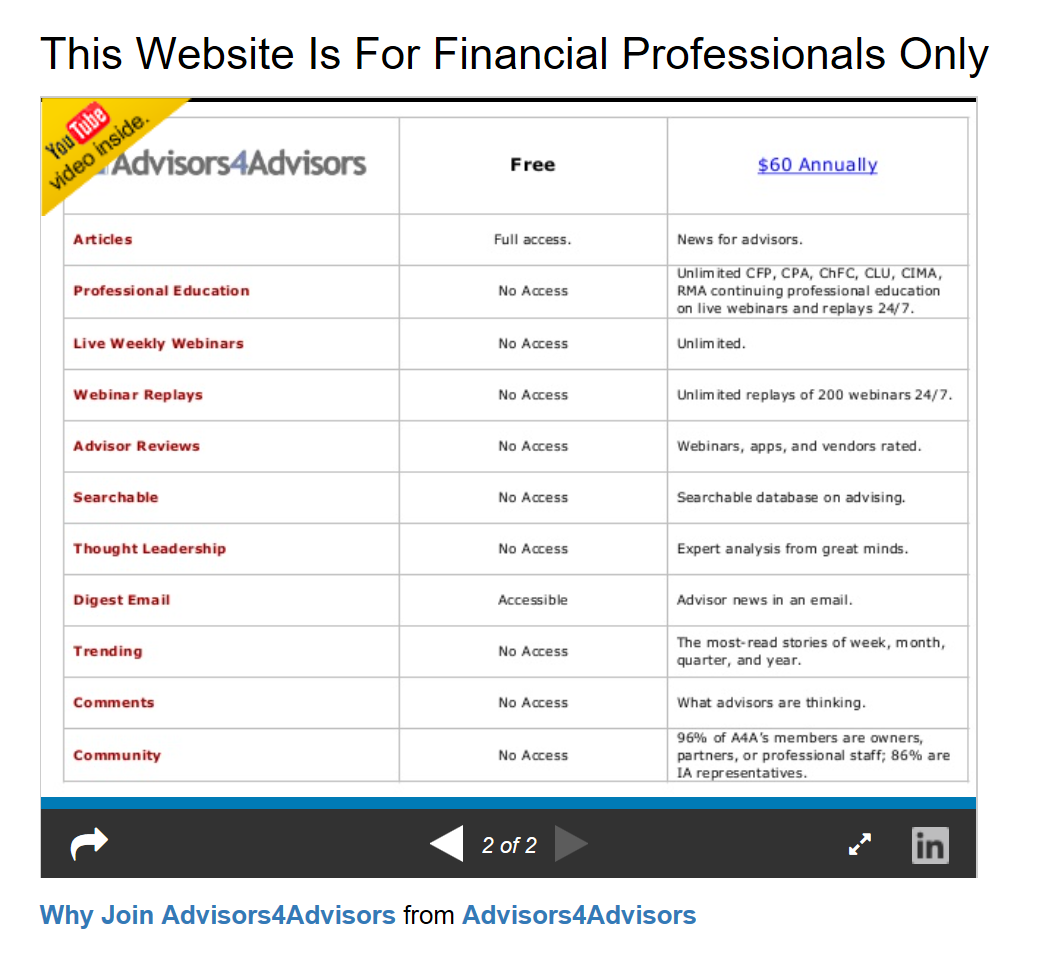Getting Your RIA To The Next Level: Did You Make Progress In The Past 90 Days? Hot
In my 2012 year-end post, Getting Your RIA To The Next Level In 2013: Resolve To Follow These Six Steps And I’ll Help You Follow Through, I laid out a six-step process to help your firm make progress in 2013. In my March 12 post, the first 90-day follow-up was posted. We are now nearing the end of the second 90-day checkup (Quarter 2) of 2013.
Have you worked your way through each of the six steps?
Step One: Create a strategic plan and refer to it throughout the year to guide the firm.
This step is a series of smaller decisions that need to be determined by the leaders of the firm. It includes deciding on a mission (core focus) and vision (who and what is your organization, where is it going, how is it going to get there) just to name a few. The vision will point you to where you want to be in the future. From there, develop longer-term goals (more than 90 days) and identify shorter-term tasks and projects (less than 90 days) that need to be completed to reach your longer-term goals.
Develop your updated 90-day goals to reach by September 30. Roll over any from the previous 90-days that still need to be completed.
Have you developed your strategic plan and refer to it on an ongoing basis? Have you identified your vision? What are your longer-term goals? What tasks and projects need to be assigned and completed to reach your 90-day goals?
Step Two: Assign someone in your firm the role of “Implementer.”
In a smaller firm, the Implementer will likely be the President/Owner. In a larger firm, you may (should) have someone else with the right skill set to handle this role. It would be a good fit for someone handling the COO responsibilities or it could also be outsourced to a business coach (someone who can hold staff accountable).
The key responsibilities of this role are: 1) make sure the firm has the correct staff in place to reach longer-term goals, 2) prioritize shorter-term tasks and projects and ensure that progress is being made on these as well as toward reaching the longer-term goals, 3) assign tasks to the correct staff members and hold them accountable for completing these.
Holding your staff accountable for completing these shorter-term tasks is critically important to reaching the longer-term goals and ultimately the future vision of your firm.
Identify someone to fill this role or you may forever be stuck in a rut. The Implementer role is extremely important for continuing to make positive progress toward your longer-term goals.
Who is the “Implementer” for your firm?
Step Three: Make sure you have the right staff in place to execute your strategy.
Sometimes, for a variety of reasons, the person in a particular role is not the best person for the position. Sometimes they start out strong in the role, but over time, their career path interest and/or strengths may change. The employee may also have outgrown their previous role. As the firm’s needs change, so to do changes in employee responsibilities. Make sure you are always staying slightly ahead of your firm’s personnel needs.
Analyze your current staff and identify any changes or additions you need to make. Do you have the correct staff in place?
Step Four: Focus on critical tasks and projects that move the firm toward longer-term goals.
Look at all the issues your firm struggles with and the projects you need to work on to move your firm ahead. Prioritize each issue and place those with the highest “need to be completed” in the next 90 days at the top of the list. Decide what can and needs to be completed today and this week to remove the issue or gets you closer to completing the project.
What issues and projects need your attention? What can you do today and this week that moves you closer to resolving issues and completing tasks and projects?
Step Five: Assign accountability for completing the shorter-term tasks and projects.
Once the issues and tasks have been identified, assign accountability for completing each of these. Spread them out to the correct individual(s) and place deadline dates on each task.
Who will be responsible for each issue, task, and project your firm is working on?
Step Six: Measure your progress.
Have the Implementer meet weekly with your staff to measure your progress on the shorter-term issues, tasks and projects. The Implementer also has authority to hold people accountable. This is also the time to address anything holding up completing these by the dates set. After doing this weekly, when you reach a 90 day time period, you should begin seeing progress toward your longer-term goals. Once you begin seeing progress, it develops momentum in the organization.
Are you consistently and methodically measuring your progress?
Momentum?
If you followed these Six Steps beginning in January, have you noticed progress (a little or significant)?
If you have not yet started these steps, begin with Steps One today. After you get going for a few weeks, stop and measure your progress. Are you making progress on each of your tasks and projects (Step Four)? Continue working on Step Two through Step Five and follow up periodically with Step Six to see how you are progressing.
If you follow these Six Steps consistently and I am confident you will see your firm progress in the direction you envision. Seeing progress builds momentum.
I’ll follow up again in 90 days (Quarter 3) to see if you are making progress toward your goals. It takes discipline, patience, and focus to reach what you set out to accomplish.
Half of 2013 is almost gone. Keep moving toward your goals!
Build your business wisely.









